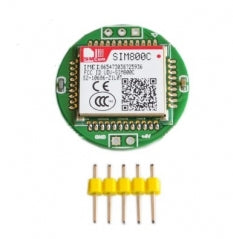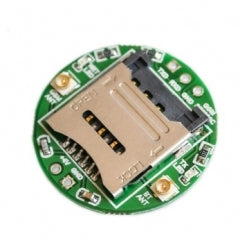Checking your system from afar would be a piece of cake by using this module. Enabling GSM/GPRS feature for your project would give you much advantage, especially in controlling or checking your system. But having a wearable device that can do those is another level.
This module uses the SIM800C chip that supports Quad-Band 850/900 1800/1900 MHz. It has a low power consumption at around 0.6mA in sleep mode and can power-up from your preferred microcontroller, or a separate power supply ranging from 5V to 12V. It features GPRS multi-slot class 12/ class 10 with a maximum of 85.6 downlink/uplink speed.
SIM800C is also compliant to GSM phase 2/2+: Class 4(2W at 850/ 900 mHz), class 1(1W at 1800/1900mHz).
It has built-in headphone and microphone jack to easily make/take GSM voice calls. It has static chip protection for the SIM card, where it generates static electricity when the SIM is in the SIM slot for protection. It also has an RTC with battery backup. It supports point-to-point mobile-oriented(MO) and mobile terminated(MT) messaging as well as unstructured supplementary service data(USSD). It supports SMS cell broadcast, meaning sending a message to multiple receivers wouldn't be a problem.
You can do what a standard phone could do, like sending/receiving an SMS, making/taking a call, connecting to GPRS(data) for internet usage. You need this if you want to make a DIY mobile phone.
This module is a GPRS Class B meaning it could only do one service (GPS/GPRS) at a time. To elaborate, you could receive/make calls or send/receive an SMS during a GPRS connection, but the GPRS service is suspended and resumes once done with call/SMS.
With this small module with a quarter dollar size, you could incorporate this into wearable and portable projects.
In the world of IoT (Internet of Things) and smart devices, the GSM/GPRS SIM800C module stands out as a powerful tool for enabling communication over cellular networks. This module is particularly popular among hobbyists and developers using Arduino due to its ease of integration and robust functionality.
Here, we’ll dive into the features, applications, and setup process of the SIM800C module, providing insights for both beginners and experienced makers.
What is the SIM800C Module?
The SIM800C is a GSM/GPRS module that allows your Arduino projects to send and receive SMS messages, make voice calls, and connect to the internet via GPRS. With its compact size and low power consumption, it’s ideal for a wide range of applications, from remote monitoring systems to smart home devices.
Key Features of SIM800C Module
- Compact Size: The SIM800C module is small and lightweight, making it easy to integrate into various projects without adding bulk.
- Multiple Communication Options: It supports SMS, voice, and GPRS, enabling versatile communication capabilities. This means you can not only send texts but also establish voice calls and connect to the internet.
- Wide Voltage Range: The module operates within a voltage range of 3.4V to 4.4V, allowing for compatibility with most Arduino boards without the need for additional voltage regulators.
- Easy to Interface: The module uses standard serial communication (UART), making it easy to connect with Arduino and other microcontrollers.
- Global Coverage: As a GSM module, it can work with various cellular networks worldwide, provided you have a compatible SIM card.
Applications of SIM800C Module
The versatility of the SIM800C module opens up a plethora of potential applications:
- Remote Monitoring: Use the module to monitor environmental conditions or other metrics and send alerts via SMS.
- Smart Home Systems: Integrate it into your home automation projects to control devices or receive notifications remotely.
- GPS Tracking: Combine it with GPS modules for location tracking applications, allowing you to send location data via SMS or GPRS.
- IoT Projects: Connect to cloud services for real-time data processing and control, making it ideal for IoT solutions.
Getting Started with SIM800C Module
To begin using the SIM800C module with your Arduino, follow these steps:
- Hardware Setup: Connect the module to your Arduino. Generally, you’ll connect the TX pin of the module to the RX pin of the Arduino and vice versa. Also, connect the GND and power supply pins. Be cautious with the power supply, as the SIM800C can draw significant current when establishing a connection.
- Install Libraries: You may want to use libraries such as TinyGSM or Adafruit FONA to simplify coding. These libraries provide pre-built functions for sending SMS, making calls, and connecting to the internet.
- Write Your Code: Start with basic functions like sending an SMS or making a call. Test these functionalities before moving on to more complex tasks like internet connectivity.
- Testing: Once your code is ready, upload it to your Arduino and test the module’s functionality. Ensure your SIM card is active and has sufficient balance for sending messages or making calls.
Conclusion
The GSM/GPRS SIM800C module is a fantastic addition to any Arduino enthusiast's toolkit. Its ability to facilitate communication and connectivity opens up endless possibilities for innovative projects.
Whether you’re building a simple SMS alert system or a complex IoT application, the SIM800C module offers the features and reliability you need to bring your ideas to life. With some basic setup and coding, you’ll be well on your way to creating smart devices that can communicate effectively in today’s connected world.
QUICK LINKS:
GSM / GPRS SIM800C Module for Arduino
GSM / GPRS SIM800C Module for Arduino
Out of stock
Product Code
SKU:AB807
Couldn't load pickup availability




